Tenant Spotlight: Just Be Woodsy
What happens to a tree in downtown Toronto that needs to come down?
Usually, it is ground up into wood chips for landscaping mulch. But in 2016, Robert Jarvis and Sinéad Wills saw the opportunity to both reduce the CO2 emissions of that process and celebrate the beauty of urban trees by transforming them into functional furniture and beautiful objects.
After winning a bid with the City of Toronto to salvage trees downtown, Jarvis and Wills connected with us at TAS to set up shop at our 2 Tecumseth Street site. For five years, their company Just Be Woodsy milled, kiln-dried and handcrafted these felled trees at the former abattoir.
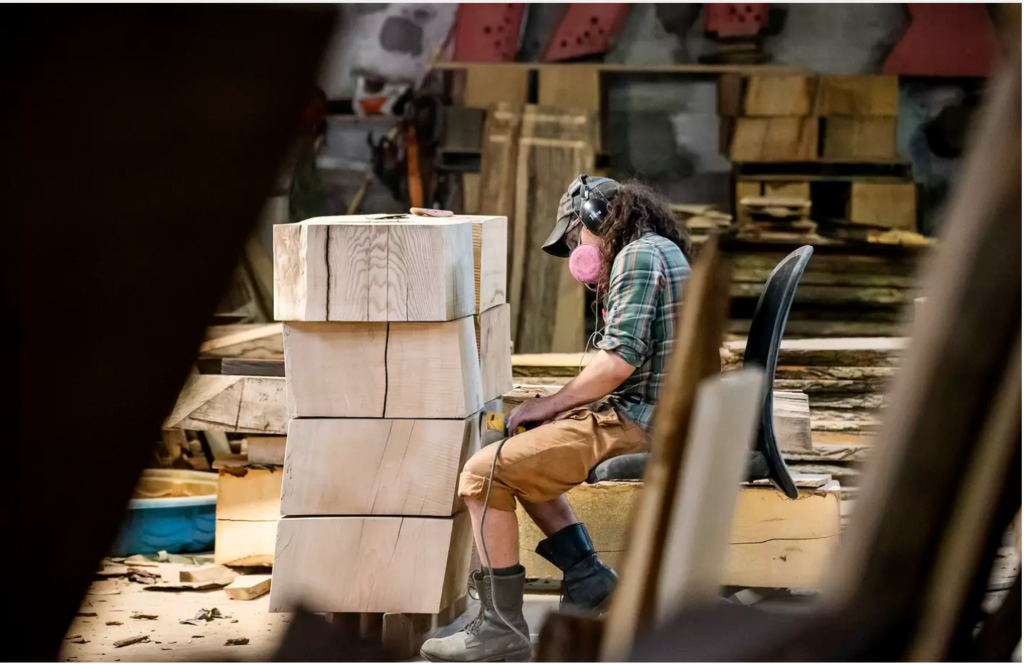
“We are incredibly grateful for our time at 2 Tecumseth. We felt part of a historical place and did our best to honour it by making use of the old infrastructure, salvaging useful resources and re-animating it for the community. Our favourite saying was Hogtown to Logtown. It truly provided us a foundation to build a company,” said Robert Jarvis, co-founder of Just Be Woodsy.
Today, Just Be Woodsy has a 7-person team. Its furniture can be found all over Toronto and it has major contracts with the 1 Hotel and the University of Toronto. A signature of its work is the engraved coordinates of the tree’s place of origin, connecting buyers to the urban forest around us.
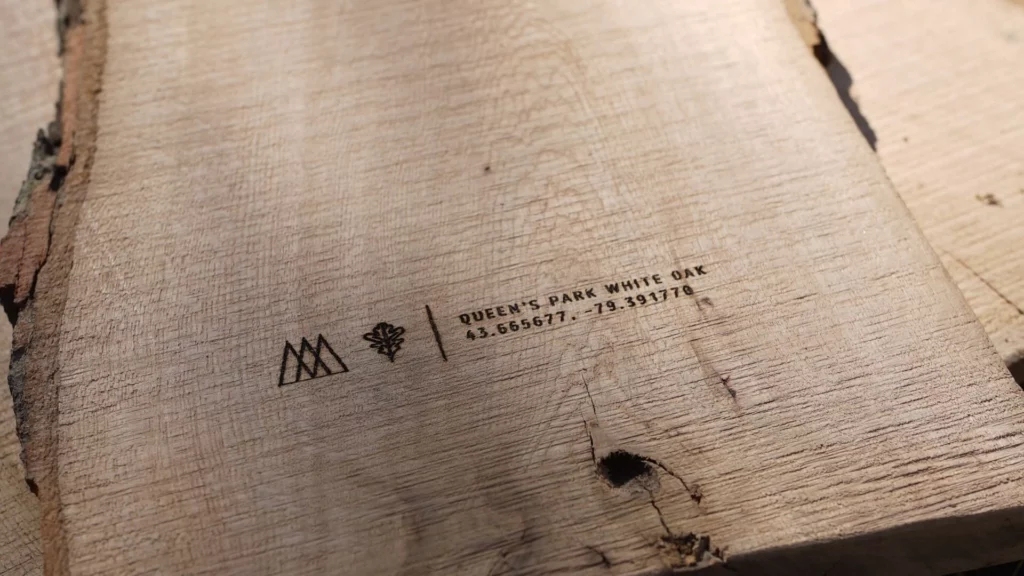
Beyond giving these trees a second life, this process also sequesters carbon. Wood is about 50% carbon and when that wood becomes a table or tray, the carbon is secure. According to Just Be Woodsy, the team has salvaged over a million kilograms of CO2, which is the equivalent to planting over 15,000 seedlings and watching them grow for 10 years.
At TAS, we are determined to activate our sites while we work through the research, engagement, design and municipal approval processes. Our partnership with Just Be Woodsy is a perfect match. Our two companies are aligned in our mission to create beautiful designs while reducing emissions and harm to the planet. We’ve been proud to incubate and watch their business grow over the past 7 years.
In late-2022, Just Be Woodsy moved to a new home at 772 Warden Avenue, a building in TAS’s Commercial Community Hub portfolio. Learn more about their impact story at justbewoodsy.com and come visit their new showroom to see the projects for yourself!
Benefits and Pensions Monitor: What is Impact Investing?
This article first appeared in the December 2022 issue of Benefits and Pensions Monitor.
The need to mobilize capital to address the consequences of climate change, global health challenges, and social inequality has never been greater.
Most people are now familiar with the term ESG (environmental, social, and governance) and many investment firms are pitching ESG investing strategies. However, ESG is not truly an investing strategy; rather, it is a framework for assessing a company’s practices and past performance around sustainability and how those practices may help or hinder a company in generating financial returns to investors. In addition, the work that the newly-created International Sustainability Standards Board (ISSB) is doing to set IFRS (International Financial Reporting Standards) Sustainability Disclosure Standards will help harmonize reporting standards. However, additional reporting will not by itself help address the challenges facing us today.
That’s where impact investing comes in. Impact investments are made with the intention to generate positive and measurable social and environmental impact alongside a financial return. Impact investing is a tool that can help us tackle some of the most complex issues facing society today. It is a forward-looking mandate to generate risk-adjusted market returns while avoiding or restoring environmental damage and generating positive outcomes for society. Intractable challenges, seen through an impact lens, become solvable; opportunities are pursued with social and environmental systems in balance.
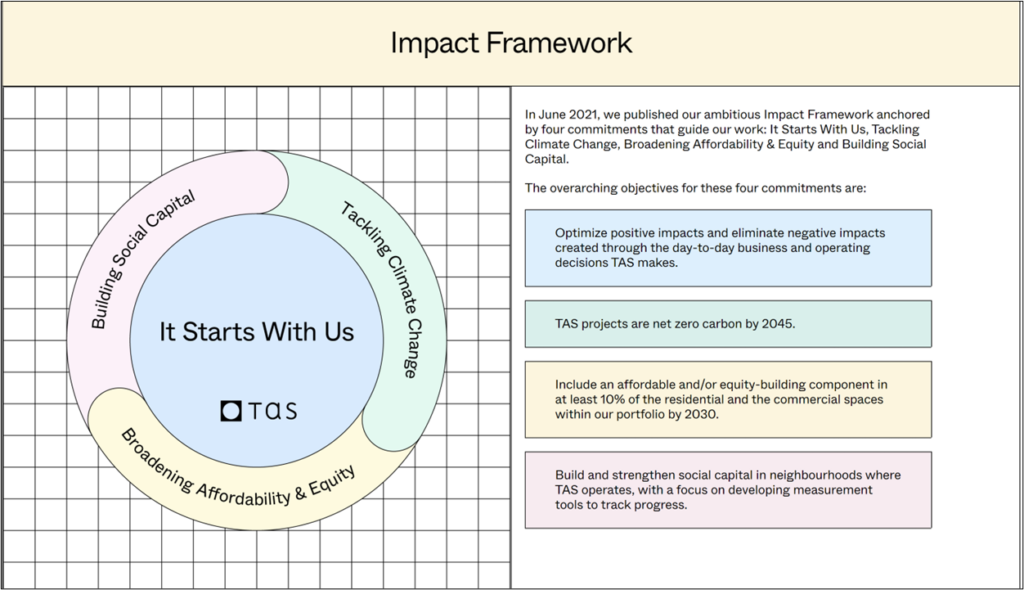
TAS is proud to be at the forefront of real estate investors and developers focusing on impact investing.
What Does A Good Impact Strategy Entail?
There is growing recognition that the singular focus of businesses and investors on generating financial profits and shareholder returns in the short run is damaging in the long run. Historically, businesses and investors have failed to internalize social and environmental costs. By contrast, when we take a systems view, we no longer see business’ so-called externalities as immaterial. Successful, sustainable businesses create long-term value, operating in a way that addresses social equity and functions within the carrying capacity of the earth while generating financial return.
While an impact investment strategy may be thematic – think tackling climate change; finding ways for tenants to share in the value created by having them in a building; funding female and minority-owned businesses – a good strategy should be comprehensive and look beyond the narrow focus of the core positive impact of a business model, product, or service. The concept of double materiality should be applied; consider risks and opportunities to the investment and the negative and positive impact the investment can have on society and the planet.
The Impact Management Platform, a collaboration between leading providers of public good standards and guidance for managing sustainability impacts, provides practical tools to contextualize impact across five dimensions (what, who, how much, contribution, and risk). The Global Impact Investor Network (GIIN), a global membership-based organization championing impact investing, hosts the IRIS+ catalogue of impact indicators, helping to standardize impact measurement wherever practicable.
Impact measurement should be based on a clear theory of change for each strategic priority using the lens of double materiality and needs to be integrated into a day-to-day approach of a business. Output indicators quantify efforts across operational and product/service delivery, while the five dimensions of the impact management platform can be used to contextualize the impact achieved. Impact performance data should be operationally relevant, providing insight into how to better integrate impact into the value proposition of the business.
What Value Does Impact Investing Bring?
Applying the impact lens to an investment strategy ushers in a systems view of the world ‒ one that identifies risks and opportunities for value creation. It shifts capital to align with the needs of society and to work within the carrying capacity of our planet. More importantly, capital deployed with this lens can reverse course on the destruction of the environment and address structure inequities that limit the potential of millions of people.
This shift delivers triple bottom-line returns. In fact, evidence has shown that impact investment portfolios are providing competitive risk-adjusted returns. In the last GIIN Impact Investor Survey, 88 per cent of impact investing respondents reported meeting or exceeding their financial expectations and over two-thirds of respondents (67 per cent) sought risk-adjusted, market-rate returns for their assets. This confirms that while some impact investors, particularly those seeking to deploy philanthropic assets, may do so as an efficient way to achieve impact objectives, most investors applying an impact lens do not tradeoff between impact and financial performance and instead seek and achieve risk-adjusted market-rate returns alongside measurable positive impact. Simply stated, impact investing is an evolved lens on solid business fundamentals.
At TAS, we are optimists. While we see the challenge ahead of us, we also see great possibilities. In October 2022, the GIIN estimated the size of the worldwide impact investing market was US$1.164 trillion, marking the first time that the estimate has topped the US$1 trillion mark. While positive, we need to mobilize trillions more to address the world’s pressing challenges posed by growing inequality and the numerous environmental crises ‒ from climate change to habitat destruction. Set against a backdrop of ongoing pandemic disruptions, geopolitical tensions, and unsteady world financial markets, the need has never been greater to shift the power of capital towards solving these global challenges.
Impact investing is catalyzing that shift and showing the power of combining purpose and profit.


Written by Mazyar Mortazavi, President & CEO
and Kate Murray, Director, Impact Strategy & Measurement
Creating impact through engagement at 38 Walmer Road
Phase 2 of our community engagement work at 38 Walmer Road.
The Walmer Road Baptist Church has served as a welcoming, expansive place where diverse communities have connected since 1889. The striking landmark stands in the heart of the Annex, one of Toronto’s most dynamic and storied neighbourhoods.
Along with our partner, the Walmer Road Baptist Church, TAS has been working with a team of designers, heritage experts and planners to develop a bold new vision for this site that also celebrates the rich history of the church, and the Annex community. Over the course of 2 years, more than 300 local residents have participated.
Phase 1: Our Listen First Approach
At TAS, we take a ‘listen first” approach to community engagement. We started engaging with the community in 2020, with the commitment to learn and incorporate a diversity of perspectives into the design and programming of the site.
Last year, we challenged ourselves to come up with new ideas and activities, and to dig deeper and honour histories and peoples that predate the church. We hosted a multimedia art installation on site in partnership with Ophira Calof and their team, the ReelAbilities Film Festival and ArtworxTO. We also hosted three guided story tours that explored the site’s past and present and created a platform for dialogue about its future: one hosted by Ophira focused on accessibility; the second focused on Indigenous histories, experiences and Truth and Reconciliation hosted by First Story guides Trina Moyan and Jill Carter; and the last was hosted by the Walmer Church Congregation.
Watch the recap of that engagement work here: 2021 Walmer Road Baptist Church engagement
Phase 2: Testing and Implementing Through Engagement
In 2022, we began testing and implementing what we heard from the community. Our goal was to provide opportunities for people to gather and engage with each other – because that is how we envision the future of this site.
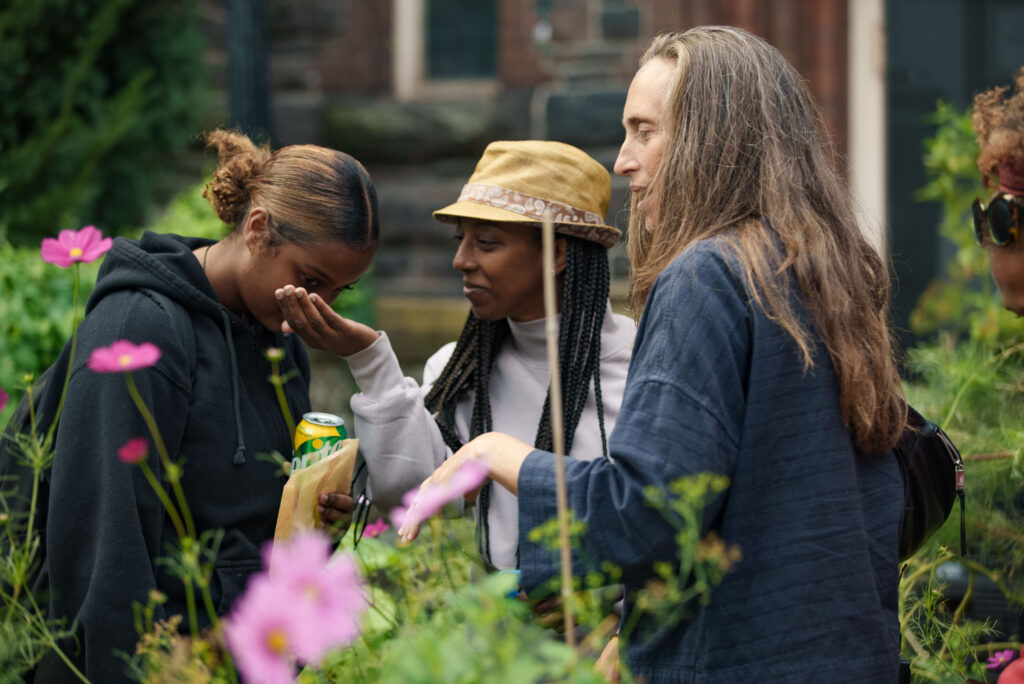
- The Bowery Project
The Urban Crate Farm, run by Bowery Project, included 500 crates of herbs, flowers and vegetables grown along the steps of the church. Bowery Project managed weekly programming and volunteers to care for the gardens and harvest the crops. The greens were collected by residents, as well as donated to the Native Canadian Centre of Toronto and Native Women’s Resource Centre.
- The Fall Festival
The Fall Festival brought together members of the community and the church congregation for food, music and activities. It was an opportunity to build on community-identified priorities like creating welcoming, vibrant public spaces, as well as TAS and our neighbours to get to know each other a bit better.
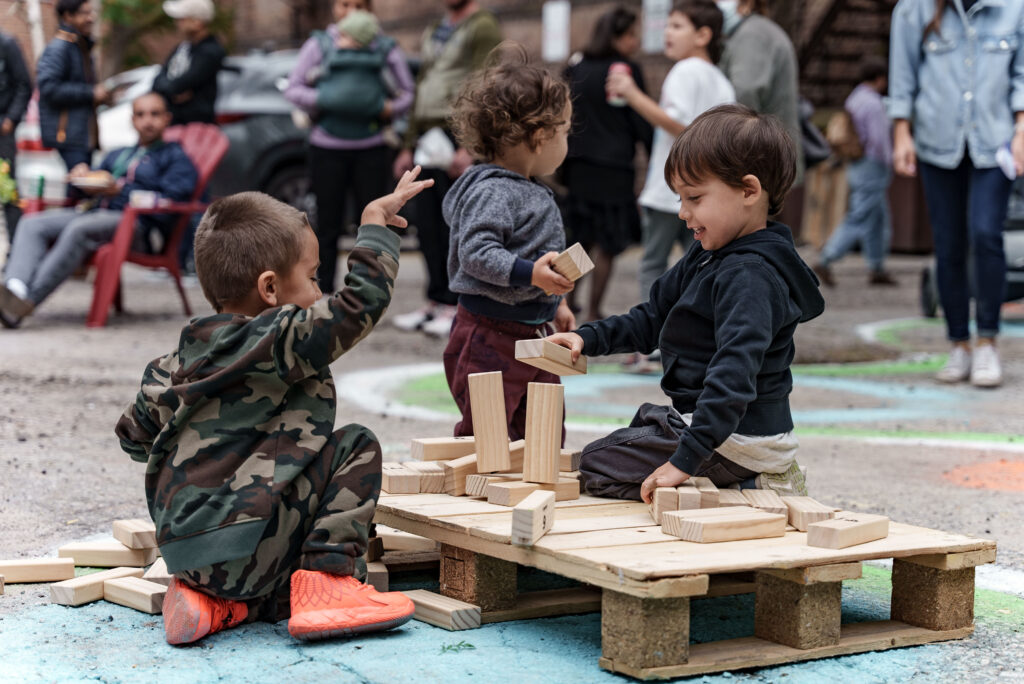
- Jon Blak: Sanctuary Doors
As part of the Scotiabank CONTACT Photography Festival, Wedge Curatorial Projects presented their inaugural public art installation on the sanctuary doors featuring photographs from Toronto-based photographer Jon Blak. His work redefines inclusive spaces to celebrate merging identities and styles that reflect the multiplicity of Toronto’s Black community. This installation reflects what we heard from the community about the need for diverse stories and perspectives to be represented on this site.
- Community Fridge
Community Fridges TOronto is a mutual aid project that provides 24/7 access to free food for community members facing food insecurity. This fridge was installed in early 2022.
Why do we do this?
At TAS, we understand that every neighbourhood is unique, and so how and what we design, program and build also needs to be different every time. That’s why we invest time listening, learning and exchanging ideas with the people who live, work or spend time in the neighbourhood.
These initiatives are as much about the projects as they are about the relations between people. Because when communities are empowered to shape their neighbourhood, and they have opportunities to engage with each other, it creates a unique sense of place.
Our engagement process is ongoing. We continue to look for meaningful ways to engage the community and honour the site’s Indigenous history.
TAS is excited to be part of the Annex. We hope that through our engagement work, we are able to create something truly unique that provides real value for the community.
Our Industry’s Role in Truth and Reconciliation
TAS is listening, learning, and building relationships with Indigenous organizations.
TAS believes our industry has a significant role to play in advancing Truth and Reconciliation. The City of Toronto recently released its Reconciliation Action Plan, which builds on and is guided by The Calls to Action set out by the Truth and Reconciliation Commissions final report (2015), the principles detailed in the United Nations Declaration on the Rights of Indigenous Peoples (2007) and the Calls for Justice outlined by the National Inquiry into Missing and Murdered Indigenous Women and Girls (2019).
We, at TAS, have been putting real thought into to how we can learn from these resources and best contribute to this important process. As a first step, we’re listening, learning, and building relationships with Indigenous organizations we are inspired by, to see how we can support their work, collaborate, or build our own internal capacity. On this National Day of Truth and Reconciliation, we want to highlight some Indigenous organizations we either work with already, hope to in the future, or simply admire.
- Shared Path Consultation Initiative works towards a future in which Indigenous voices, obligations, and rights form a sustained and integral part of how we share land and water, particularly with respect to land-use planning law, policy, and governance in Ontario. TAS is working with Shared Path to deliver a Truth and Reconciliation Learning Program for #TeamTAS to help us build internal capacity to effectively advance Truth and Reconciliation actions at our projects. To get a sense of what we’re learning about, check out this Shared Path and ULI Toronto webinar: 13,000 years of Indigenous History in the GTA – And Why It Matters to Planning and Development.
- The Bowery Project believes that vacant spaces should be used to grow food. Hundreds of pounds of herbs and leafy greens have been harvested from our sites at 2 Tecumseth Street and now at 38 Walmer Road, used by local neighbours, donated to local restaurants and social service programs including the Native Canadian Centre of Toronto (NCCT).The NCCT empowers the Indigenous community in Toronto by providing programs that support their spiritual, emotional, physical, and mental well-being.
- First Story Toronto researches and preserves the Indigenous history of Toronto to build awareness of and pride in the long Indigenous presence and contributions to the city. We worked with First Story to deliver a neighbourhood walking tour around our site at The Walmer Road Baptist Church in the Annex so community members could learn about and honour histories and peoples that predate the church.
- The Mississaugas of the Credit Business LP (MCB-LP) develops and manages a portfolio of for-profit enterprises for its sole shareholder, the Mississaugas of the Credit First Nation (MCFN). The goal of Mississaugas of the Credit Business Limited Partnership is to contribute to the self-sufficiency of the Nation. The treaty lands of MCFN include almost all of Ontario’s Greater Golden Horseshoe, and the MCB-LP has a wide range of sub-contracting services that the real estate development sector can work with.
- The Gord Downie and Chanie Wenjack Fund (DWF) aims to build cultural understanding and create a path toward reconciliation between Indigenous and non-Indigenous peoples. With two national programs, Legacy Schools and Legacy Spaces, DWF provides access to education on the true history of Indigenous people in Canada and the history and legacy of Residential Schools, encouraging “reconciliACTION” by way of programming and events.
We’re at the very beginning of our Truth and Reconciliation journey. We have a lot to learn, and we know we have a long way to go. Here at TAS, we often say that ‘we can’t do it alone.’ We encourage others in our industry to share with us the organizations and people who inspire them, so that we may learn from each other as we move forward.
Guest Blog Post: The Backyard Urban Farm Company CEO Arlene Hazzan Green
We’re excited to share this guest blog post from The Backyard Urban Farm Company (BUFCO) CEO Arlene Hazzan Green, who is launching their operations from a new home at our 10 North Queen Street project.
10 North Queen Street is part of TAS’s Commercial Community Hub strategy, which sees us transform a portfolio of underutilized warehouses across the GTHA into new, sustainable spaces for a lively mix of office, social enterprise and not-for-profit tenants.
Pinch us, we must be dreaming. How is it possible that our yearning to live off the land in harmony with nature has made itself manifest? And to our surprise, it didn’t take moving away from a bustling metropolis to farmland in the country. It happened by cultivating the best of country living in the city and by discovering a thriving community of city-dwelling nature-lovers who share the very same dream.
Despite the mounting challenges of exorbitant real estate prices, outdated food policies, inflation, and systemic inequities, many local food growers, producers and businesses have found innovative and sustainable methods of bringing healthy, fresh food to our tables. And we are thrilled to be counted among them.
But we haven’t done it alone. Thanks to our growing relationship with the very forward-thinking TAS, we’re excited to announce that we are part of their new initiative to transform existing industrial warehouses into dynamic commercial community hubs where like-minded businesses can thrive.
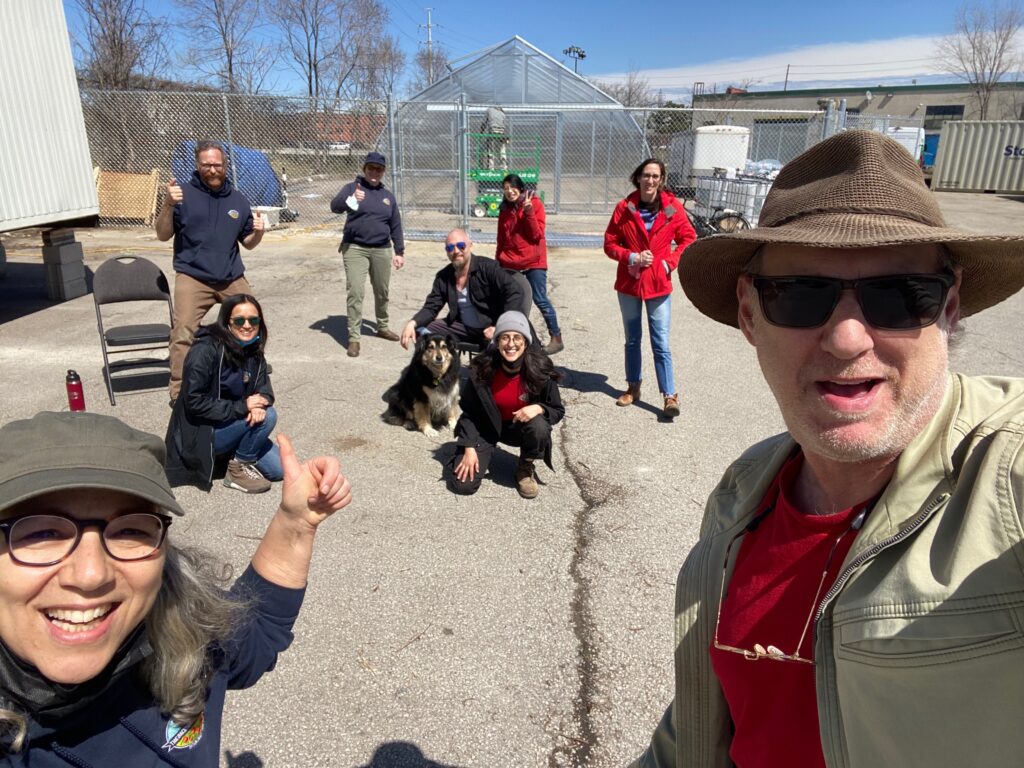
What it means in practical terms is that after 12 years of operating from our home in Roncesvalles Village, we have found a new home with TAS in south Etobicoke where we can lay down roots for the long term. We moved into the building and have built our own hoophouse, established a woodworking shop and setup portable offices and storage where we can serve our clients with greater ease and efficiency.
TAS and BUFCO’s missions align so beautifully. We are thrilled to have this opportunity to partner with a high impact company that champions conversation and collaboration in order to push the boundaries of innovation and explore what is possible. We have experienced this firsthand, with support over the years through discussion, planning, dreaming, problem solving and visioning for the future. #TeamTAS understands the many challenges that small, local businesses like ours face and have been key to helping us establish our permanent home at 10 North Queen Street.
We are not the only small business that benefits from their clear vision of livable cities of the future. TAS believes that affordability, climate change and social capital are the most pressing issues facing our neighbourhoods, and thankfully they both talk the talk and walk the walk. As happy beneficiaries of this vision, BUFCO is now able to expand our ability to inspire, enable and empower urbanites to grow their own food and help them to reconnect with nature.
We welcome those who have made an online purchase for vegetable, herb, fruit and flower seedlings and other garden goodies to pick up their orders at our new yard at 10 North Queen Street in Etobicoke. We are not set up as a retail operation and can’t accommodate drop ins but please stay tuned for possible events in the near future. And if you haven’t ordered your certified organic seedlings yet, there is still plenty of stock available at bufco.ca/seedlings.
About BUFCO: After three successful decades working in the motion picture industry, husband and wife team Arlene Hazzan Green and Marc Green co-founded The Backyard Urban Farm Company (BUFCO), an award winning, organic vegetable landscaping company in Toronto. They are on a mission to inspire, educate, and empower urbanites to grow their own food and help them reconnect with nature.
Camron PR 2022 Power of Design Report Feature: ‘How to Solve a Problem Like the City’
This article originally appeared in Camron PR’s inaugural Power of Design 2022 Report. Download the whole publication for free here.
How to Solve a Problem Like The City
A Toronto-based family business is making waves for its innovative approach to city planning, connecting purpose and profit while keeping communities at the core.
By Jonathan Openshaw
—
Big problems call for big solutions. From social equity to climate collapse, the world is awakening to the fact that taking a case-by-case approach is not going to cut it. What’s needed are grand, multi-generational visions that can bring about lasting change.
Few problems loom as large as cities in the 21st century. At some point around 2006 (according to the United Nations) humanity sailed over an invisible line where – for the first time in our history as a species – more people lived urban lives than rural. Since then, we’ve flooded into urban centers in our droves, with the UN forecasting that 68 percent of the world will call cities home by 2050. Not even the global pandemic seems to have slowed this long-term trend in any significant way.
Cities are the undisputed engines of our social, political and economic life, and should be celebrated as such. But they also have the potential to wreak havoc on the wellbeing of those who dwell in them.
The big battles of the 21st century – from health to equity to pollution – will be fought in urban centres, not rural hinterlands.
The problem is that cities have too often been shaped by the short-term needs of property developers and politicians, who may be looking for a quick buck or positive news story over long term investment. Much of our globalised world has become addicted to short-termism, it seems. Tied to financial quarters, annual reviews and midterm elections, we operate on the scale of hours, weeks and months, rather than decades, centuries or millennia. Can we find another way?
“The fact that we’re a family business is crucial,” says Mazyar Mortazavi, President and CEO of TAS, the Toronto-based real estate business that his parents founded as Iranian immigrants in the 1980s. “I think it really comes down to our family values: that set of ideas that underpins what we do. It takes on a multi-generational aspect.” This approach has echoes of the so-called Cathedral Challenge: a way of enacting long term change that stretches beyond the lifetime of an individual. The name references the cathedral building families of mediaeval Europe, where the grandfather would lay the foundations, the father would build the structure and the son finish the masonry. No single generation oversaw the whole, but all contributed to a singular vision. “We live in a time where capital has become about extraction rather than generation,” continues Mortazavi, “where we try to extract as much as we can, as quickly as possible, and just leave a hole for the next generation to deal with.” By taking on a multi-generational construct that attributes value to the social, environmental and cultural as well as the financial, TAS has made a mark on Toronto, and is rightly beginning to garner global attention for their approach. “Rather than calling ourselves a real estate company, we say we’re an impact company that uses real estate as a tool,” says Mortazavi.
Even over video link, Mortazavi is an impassioned and charismatic speaker, and a cynic could dismiss his vision as the kind of corporate spiel that we hear from various messianic Silicon Valley types. The difference is that TAS have been assiduous in holding themselves to account, not only obtaining B Corp certification, but launching their own Impact Framework earlier this year. Linked to the independent Future-Fit Business Benchmark (which in turn is grounded in the United Nations Sustainable Development Goals) the Framework applies concrete criteria to all TAS projects. As such, it formalises the TAS family-values approach into a set of measurable environmental, social and governance criteria.
“I would stress that this is not about becoming a charity or operating purely altruistically,” explains Mortazavi. “Real estate is big business and we have a deep respect for the financial aspect of what we do. We cannot create change if we’re not financially successful, so it’s not about suddenly slashing profits from, say, 25 percent to 5 percent.
But it’s also possible to have a significant social impact from quite a subtle shift in value attribution.” Many companies tout purpose and profit, but few in the real estate sector have tied themselves quite so closely to measurable, multi-generational responsibilities.
At the core of the TAS approach sit the communities and neighbourhoods of Toronto – the type of small-scale groupings that have so often been bulldozed and displaced in cities around the world. “A great neighbourhood allows people to connect and care for one another,” says Mortazavi, “when neighbourhoods work well, cities work well, and we have models to prove this throughout history – from rural villages to mediaeval towns.”
Mortazavi has the academic training to back this statement up. As well as studying architecture, he wrote a thesis on the eastern bazaar as an enduring system of social cohesion. “If you look at the fundamental structures of a bazaar then they haven’t changed in millenia, and yet they have retained a vibrancy that comes from their incredible ability to flex and adapt,” says Mortazavi. “We used to have this in mediaeval Europe, too, but with the Renaissance came an obsession with the individual and with monolithic architecture. We lost that more organic, community-driven focus.”
This community model can still be found in successful neighbourhoods the world over, with Toronto’s own Kensington Market providing a prime example. Often cobbled together by disenfranchised groups outside the purview of city planners or politicians, such spaces were able to grow through small-scale social cohesion. Of course, it’s impossible to turn the complexity of today’s mega city over to communities alone, but the challenge as Mortazavi sees it is how to retain these social bonds within a grand city plan.
“I guess carpet weaving is in my Iranian roots,” chuckles Mortazavi, “I want to bring different threads together. The amazing thing about weaving is that you can have these very delicate strands individually, but when you combine them they become incredibly strong.” TAS has been receiving a lot of press recently for the innovative development of the Wellington Destructor, an 1920’s trash incinerator that will now take on a new lease of life as a multipurpose space that weaves culture, commerce and leisure. Just as important as these big blockbuster projects are more subtle combinations, however, such as rehousing a 10,000 square foot Salvation Army in the ground floor of a gleaming new residential development, or working with the City to bring a public library to another underserved area. “It’s about looking at what makes a community special, or identifying what a community might lack, and blending that together.”
A side-effect of the global pandemic is that it made us connect far more deeply with our immediate neighbourhoods, and it may result in a greater planning focus on walkable clusters of mixed amenities within global cities. This idea of the 15-minute neighbourhood has long been a priority for visionary planners from Jane Jacobs to Jan Gehl, but too often it got pushed aside by the more prosaic plans of politicians. “I think the pandemic has really made us focus on our core needs from the streets in which we live, and those needs may be as simple as the butcher, the baker, the candlestick maker,” says Mortazavi. “We need to stop kidding ourselves that we know better than our communities do. It’s the job of professionals to create the fundamental infrastructure, but to leave plenty of room for the magic that is community building.”
Combining a multi-generational vision with commitment to community, TAS is showing how it’s possible to develop neighbourhoods with soul – and without impacting your bottom-line as a business. The challenge of living healthy, fulfilling, vibrant lives in high density cities is one of the biggest that lie ahead of us, but the world could do worse than look to this Toronto-based family business for some inspiration.
TAS Releases Impact Framework
Impact is Our Purpose, Real Estate is Our Tool
A note from our President & CEO, Mazyar Mortazavi:
Positively impacting people’s lives has always been at the heart of what we do here at TAS – it’s embedded in our DNA and in our approach to life. As new immigrants to Canada 40 years ago, my parents founded TAS because they saw custom home building as a powerful tool that could help families thrive. Our toolkit and impact ambitions have evolved significantly since those early days.
We started building mixed-use condominiums in the early 2000’s and we experienced a serious setback during the financial crisis of 2008. I learned some hard lessons about over-leveraging in the pursuit of profit, and it forced me to reflect on the company’s purpose. When I set out to rebuild TAS, I was determined to create a new and different kind of development company – one that sets a new standard for how business can drive profit as well as positive outcomes for people and the planet.
And so, for the last few decades, building on our roots as a people-focused company, we’ve been testing, trying and innovating for impact. For TAS in 2021, real estate is our tool, not our purpose. And that’s why we describe TAS as an unconventional impact company. We promote connected neighbourhoods and caring, committed communities. We believe that profit is foundational, but not the only goal. We measure success in our ability to push the boundaries of innovation to better serve the people of today and future generations.
On behalf of the entire TAS team, I am thrilled to introduce this impact framework which marks a major step forward in our long-standing commitment to support society and the environment through our work.
The framework is the result of decades of deep engagement with the communities we serve, a healthy dose of learning-by-doing, and an in-depth evaluation project over the past six months to review the best available impact methodologies and practices. Our new framework formalizes our approach to impact through an ambitious set of objectives – including environmental, social and governance factors – and charts a path forward for how we’ll track our progress over the coming years and decades.
We have selected the Future-Fit Business Benchmark to strategically anchor our approach. In our view, it is the most comprehensive and leading-edge methodology out there. Grounded in the United Nations Sustainable Development Goals, Future-Fit provides a roadmap to:
- Comprehensively assess and eliminate any and all negative externalities created by our work; and
- Focus our pursuit to positively impact people and the planet by tackling climate change, broadening affordability and equity, and building social capital.
To demonstrate our unwavering commitment to creating a society that can flourish in the 21st century, we are the first real estate platform in the world to declare ourselves a Future-Fit Pioneer. I’m proud that we’ve taken this bold leap, which expands our long-standing ambition to positively disrupt and lead a systems-change towards purpose within our industry.
It is critically important to highlight that none of this can be done alone. We all need to work together – across public and private sectors – to ensure a vibrant and resilient shared future. Our TAS team will continue collaborating with a wide range of partners to deliver and scale our impact, and we hope you’ll join us and take part in this collective journey. If you have any questions, suggestions or a great partnership idea, please get in touch – we look forward to connecting.
The impact framework we’re releasing today is a statement of intent. It sets out our strategy, shares our ambitious long-term objectives and highlights the initial actions we’re taking to achieve these targets. We’ve embedding the framework in our management systems and will publish a detailed metrics-based progress report annually starting in mid-2022. We are committed to showcasing our work so that others can learn from our successes and failures as we make our way on our journey. And so, moving forward, when we research a new building material, find a new way to underwrite for impact, develop a new commercial equity sharing model, or explore a new policy idea – you’re going to hear about it. We will act as an open-source innovator in pursuit of positive impact.
We hope that you’ll find this framework as exciting as we do, and that it will spark new ideas around how you, your colleagues and your partners can make a lasting positive impact that we can all celebrate.
Let’s create that together. Download our Impact Framework HERE .